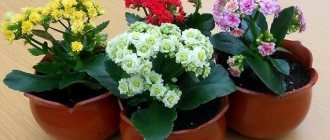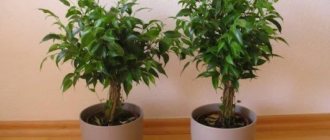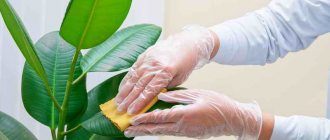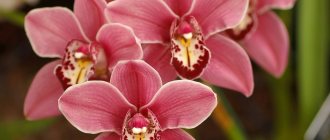Home › Folk signs › Signs about plants
- Story about the plant
- Positive signs
- Bad influence
- Popular beliefs
- Other signs
- Plant energy
- Help during pregnancy
- Feng Shui
Each indoor plant has its own purpose for humans. Some people acquire certain flowers in their home in order to attract money, luck, and love. However, there are many green pets that can both bring benefits and happiness to the house, and take away everything that is available. Among these plants are many varieties of ficus.
What does the flower symbolize?
Various signs and superstitions are associated with the ficus flower. This is partly due to the fact that ficus is considered a common indoor flower. However, many flower growers only superficially know about the signs and superstitions that are associated with it.
According to well-known signs and superstitions, not every plant can be kept at home. Especially if there are children in the family. Some couples carefully study superstitions or omens before planning a pregnancy. Beliefs also apply to ficus.
Important! Ficus benjamina is grown in homes and public places.
Under natural conditions, the tree reaches a height of several meters and survives drought and rain. During drought, the ficus sheds its leaves to reduce its need for moisture.
Benefit
Despite the fact that this type of ficus is most adapted to the climatic conditions of India, Northern Australia and Africa (where it reaches a height of 30 m), it can also be successfully grown at home. In addition to its decorative qualities, the flower is widely used in folk medicine; it is used to treat:
- benign formations;
- radiculitis;
- hematomas;
- osteochondrosis.
Poisonous or not? The milky sap secreted by ficus when shoots or leaves are damaged is poisonous, so you should not keep it in places accessible to children and pets, and all transplanting and propagation procedures must be carried out with gloves.
Ficus at home: good or bad
Since the tree has been grown for many years, there are many signs and superstitions associated with it. Experts have proven the positive effect of the plant on health. A small tree purifies the air, acting as a kind of filter.
The Benjamin variety helps eliminate germs, negative particles in the air and saturate it with oxygen. The flower can be grown in residential areas of large cities.
What ficus brings to the house
Initially, the Slavic peoples did not give preference to the beautiful plant. It was believed that ficus awakens negative emotions in a person. The tree was a sign of gossip and envy.
The influence of other countries contributed to the change in signs and superstitions. Currently, it is believed that the plant brings goodness and happiness and strengthens the family. A small tree improves the energy of a house or apartment.
Is it possible to keep a ficus at home for an unmarried girl?
Ficus Benjamin, located in the house, according to superstition, scared men away from girls. An unfavorable omen warned that the girl growing the tree would not marry.
It is noteworthy that ficus, for example, Benjamin, had a negative effect on men. Given common superstitions, people were reluctant to grow the tree.
Who and why should not keep ficus at home?
In addition to signs and superstitions, it is necessary to take into account individual allergic reactions that are caused by the presence of milky juice. If you have severe allergies, keeping ficus at home is not recommended. Ignoring severe allergic reactions can lead to asthma.
Attention! Allergies are manifested by fever and deterioration of general condition.
Diseases and pests, growing problems
Robusta is quite resistant to various diseases and attacks of harmful insects.
Spider mites are often found in the crowns. This small bug has an extremely small size; it can only be identified by its thin whitish web. Appears mainly in cases of excessive dryness.
To get rid of the parasite, you need to normalize the humidity and systematically treat with a solution of laundry soap or insecticides.
The plant may also suffer from high activity of aphids, scale insects and mealybugs. The situation is corrected by first mechanically removing insects by hand, and then spraying them with special preparations.
Common problems and ways to overcome them:
| Symptoms | Causes | Solution methods |
| curled leaves | Excess or deficiency of moisture | Normalization of the irrigation system |
| The leaves lose their natural turgor, dry out and fall off over time. | Exposure to drafts, pest activity, lack of watering or soil depletion | Regular insect prevention, systematization of growing conditions |
| Blackening of leaf plates | Sunburn | Move the plant to a place protected from direct sunlight. The affected segments are removed, the root system and crown are treated with a fungicide. |
| Brown spots on leaf blades or trunk rot | Excess moisture | Watering is minimized or stopped completely, giving the substrate time to dry 2-3 cm. |
| Yellow leaves | Iron deficiency | Iron ferrovite or chelate is added to the soil. |
Magical properties of the plant
In some countries (China, Thailand), ficus benjamina is considered a sacred plant. The owner of a beautiful flower will experience happiness and good luck. It is a source of comfort and a pleasant atmosphere. In addition, a beautiful tree can cleanse a person’s home of negative emotions.
Ficus benjamina is often purchased for the purpose of adding to the family. Signs and superstitions for the home associated with the ficus say that for successful conception you can even borrow a ficus. However, the sign is valid only if the plant is well cared for. To conceive, you need to treat the tree like a child.
Varieties of ficus: photos, names and signs
The plant is a member of the Mulberry family and is also known as the “crying tree.” Ficus includes many varieties. Experts count about 900 plant species. A significant part of ficus trees grow in the subtropics and tropics. The following varieties are grown at home:
- rubbery;
- Robusta;
- Melanie;
- Kinky.
Important! The most common type is Ficus Benjamin, which is given special importance in the home.
Signs and superstitions about Ficus Benjamin
It is believed that it was the leaves of the ficus Benjamin that Adam and Eve covered themselves with after their expulsion by God from the Garden of Eden. Thus, superstitions and signs about ficus Benjamin (variety “Natasha”) also developed as a result of various historical events.
Ficus benjamina is more often grown at home. It is an evergreen tree, growing up to 20 m (in the wild). Beautiful green leaves have a smooth surface.
Popular varieties of Ficus Benjamin include:
- exotic;
- goldenking;
- starlight;
- Natasha.
Signs and superstitions about Ficus Benjamin are related to whether the tree can be grown at home. The health benefits of the plant are also significant.
Signs and superstitions about rubber ficus
People's opinions about this variety are divided. Some signs say that the rubbery species brings happiness. While according to other superstitions it is not recommended to grow a flower at home or in an apartment.
There is a sign that the rubber-bearing variety can be called muzhegon. Thus, men do not live long in a house where this flower grows. If it is given as a gift for a wedding celebration, the marriage will not last long. It is undesirable not only for married couples, but also for single girls to keep the rubber variety in the house. The flower will scare away potential suitors.
According to some superstitions, the rubber-bearing species attracts money. It should be started by people who urgently need to resolve a money issue. For the omen to come true, the tree is placed in the office or on the table. This localization helps increase income and career growth.
You can place the rubber variety in the kitchen to attract wealth and prosperity. An unpretentious flower helps to get pregnant and bear a child, as well as facilitate childbirth.
Signs and superstitions about ficus Robusta
Ficus elastica, for example Robusta, is considered common because of its beautiful appearance and good omens. The plant differs from Ficus Benjamin in its large, dense leaves of a dark green color. Due to the large leaves, the flower looks quite impressive. That is why it can often be found in apartments and office buildings.
Leaves absorb bad energy like a sponge. Experts say that the flower not only purifies the air, but is also beneficial for the gastrointestinal tract. This arrangement helps to accumulate positive energy. The atmosphere in the apartment and house becomes calm.
Attention! In order to achieve good omens, the pot should be placed so that the leaves are turned to the west.
Signs and superstitions about ficus Melanie
This is a relatively new variety that grows in a compact bush. The plant is recommended for inexperienced gardeners because of its unpretentiousness. The disadvantages of the variety include the almost complete absence of flowering at home. To eliminate fatigue, the potty is placed near the desktop. To attract guests, the Melanie variety is placed in the corridor.
The Melanie variety restores the harmony of intimate relationships when localized in the bedroom. It should be taken into account that it is not advisable to place the tree in the center of the room.
Signs and superstitions about the ficus Kinki
This is a dwarf form of the famous Ficus Benjamin. The height is up to 40 cm. Small narrow leaves are colored light green. Caring for the flower is simple. You can easily form a bush from it.
Attention! The Kinki variety does not like permutations.
The Kinki variety is considered an excellent gift. The flower has the power to ward off evil forces from its owner. It is recommended to place the tree in the bedroom when planning pregnancy.
Who can I give a flower to?
A Benjamin ficus as a gift is the best option for purchasing a tree. If it is given by good friends, it will bring luck and good fortune into life. Popular superstitions say that it is very good to give a ficus tree when it blooms. In general, flowering indicates the fulfillment of hopes and wishes, increasing prosperity.
The Benjamin variety can be given to everyone without exception. The tree often becomes a gift for married couples dreaming of adding to their family.
Important! The plant will be able to reveal its potential only with proper care and proper care.
Where is the best place to put the plant?
There are also signs for the home associated with the Benjamin ficus. The location of the tree in the living room is important.
The flower can be placed on the east and south sides. Proximity to light is important so that the energy of the tree can fully unfold. This will bring harmony and peace to the house.
In China, trees are placed on windows. People are convinced that the flower harmonizes the home and gives comfort.
This plant is especially useful when placed in the kitchen. According to superstition, residents will not have to experience need for food. For this purpose, it is recommended to bury a coin in a pot. As the tree grows, its welfare increases. The family will always be loving and happy. There will be prosperity and a comfortable atmosphere in the house.
Ficus Benjamin, located in the kitchen, will help improve relationships between relatives. It is believed that any variety will help cope with germs in the kitchen.
Attention! A plant located in the kitchen helps reduce appetite.
Signs also relate to Ficus Benjamin and pregnancy. If a woman is planning to conceive a child, the plant should be placed in the bedroom. To make a man confident in his abilities, the tree is placed next to the bed.
There is a superstition that walking around a tub with a tree promotes conception. You can also ask a family with children for a scion.
A small tree growing in the bedroom improves sleep and eliminates nightmares. If the plant is in the living room, it attracts important people into your life.
Different types of unpretentious plants can be grown in office premises. A tree growing at work is a sign of a good mood. Flowers help to focus and concentrate.
Replanting after purchase
When purchasing a plant, you should carefully inspect it. A healthy ficus should not have the following signs:
- dry and falling leaves;
- traces of rot;
- visible damage;
- unpleasant odor from the soil (for example, mold).
Peculiarity! It is not recommended to buy ficus in late autumn or winter. A tree that is “dormant” at this time may have difficulty adapting to a new environment.
The purchased plant needs to be transplanted into a new container. The pot can be ceramic or plastic. The main requirement is that it must fit the size of the flower, not be too big or too small.
Step-by-step instruction:
- At the bottom of a new plastic or ceramic flowerpot, with a diameter 2–4 cm larger than the previous one, lay a drainage layer of expanded clay, perlite or broken brick and sprinkle it with soil;
- water the ficus;
- take it out of the old pot and place it in the center of the new one, without disturbing the earthen lump;
- fill the free space with a suitable substrate;
- water and fertilize the plant.
When replanting a ficus for the first time, the soil is completely replaced, since plants usually go on sale in a specific peat mixture. It quickly wastes its nutritional properties and does not provide the ficus with the substances necessary for its development. In addition, it is easy to pour a plant growing in peat, since the mixture looks dry on the outside, but retains a large amount of moisture inside.
How to avoid the consequences predicted in signs
Sometimes gardeners prefer not to grow a beautiful plant, fearing superstitions and signs. Experts say that first of all, it is necessary to conscientiously take care of the tree and not be negative. Only in this case, Benjamin's ficus will bring happiness and good luck.
To prevent bad omens, you need to choose the right location for flowers in the house. According to superstitions, a small tree should not be placed:
- away from windows and sunlight;
- on the north side;
- on the windowsill near the west window.
These places are unfavorable for growth. Located in the wrong place, the flower spends all its available energy to maintain its vital functions. Thus, he will not be able to help create harmony and a friendly atmosphere in the house.
Attention! For good omens to come true, you need to properly and diligently care for the flower.
Reproduction methods
Robusta can be propagated in several ways: cuttings, leaves, layering and seeds. The grower chooses the most suitable grower depending on his own capabilities.
Cuttings
The simplest and most productive method by which you can propagate ficus without much effort. The most favorable time for the procedure is the last days of winter and the first months of spring.
Absolutely any, even partially woody, segments can be used as seed material. Preference should be given not to the middle specimens, but to the apical ones.
In the process, the upper part of the stem is cut off so that 3 leaves remain on it, and the milky juice that secretes is removed from the cut site. This helps prevent blockage of plant conducting vessels. Afterwards, the shoots are slightly dried for no more than an hour and only then embedded in the prepared soil in an inclined position.
For greater stability, it is possible to stick a peg nearby to which the seedling is tied. In this case, the sheet plates must first be rolled into a tube.
Rooting of cuttings lasts from 20 days to 2 months. They accelerate the process by moderately heating the soil, raising the temperature to 28 °C and humidity to 80%.
Further care consists of maintaining the contents of the container in a moderately wet state and systematically spraying. It is also possible to create a greenhouse effect by placing a can on top, which regularly needs to be opened slightly for ventilation.
Layers and leaf
The use of layering allows you to bring back to life a flower that has lost its green mass in the lower part.
The material used can be both fully formed shoots and already mature branches, significantly larger in size than standard cuttings.
Healthy leaves are suitable for propagation
The procedure is carried out as follows:
- The most suitable segment is selected on the tree and a deep oblique notch is made. A match is inserted into the incision so that the wound does not heal over time.
- The injured area is covered with moss, which is kept moist, and wrapped in cellophane on top. Water is added under the improvised greenhouse using a syringe until the roots appear, which occurs in 2-3 months.
- Cut off the rooted branch and plant it in the ground.
When propagating by leaf, a healthy and fairly large plate is selected, separated from the stem along with the heel, then processed in a root formation stimulator and left in the liquid until root shoots form.
This step allows you to lower and place the seed directly into the substrate, while creating greenhouse conditions by means of a film stretched over the container.
Seeds
A more labor-intensive and not always effective method, for which material should be purchased exclusively from well-established suppliers.
The seeds first need to be soaked in a biogrowth stimulator, and then spread on the surface of the soil moistened with a spray bottle, without being buried in the soil.











